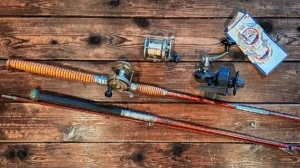Canadian bass pro Jeff “Gussy” Gustafson goes into great detail on how and where to fish the Damiki rig, his rigging methods, and a look at his go-to spinning rod setup for delivering the lure below the boat or when casting. He mastered the technique at home in Northwest Ontario for smallmouth bass and credits his 2021 Bassmaster Elite Series win to the Damiki rig. *Electronics and boat links at the bottom.
Damiki rigging, moping, hanging a minnow — they all refer to the same popular method of suspending a minnow-profiled plastic and jig in front of bass, usually in deeper water. Best known as a cold-weather technique for deep water and suspended bass, the Damiki rig is more versatile than most give it credit for — in part, thanks to forward-facing sonar.
And if there’s one universal truth in bass fishing, it’s that all three bass species eat baitfish, and fluke-style plastics are among the best baitfish imitating baits, be it shad, shiners, smelt, alewife, or ciscos (to name a few).
FEATURED PRODUCT
- PLASTIC – Z-Man Jerk ShadZ (4’’), colors – Peal and Bad Shad Buy at Bass Pro Shops Buy at Tackle Warehouse Buy at Omnia Fishing
- JIG – Bass Tactics Smeltinator Jig Buy at Tackle Warehouse Buy at Omnia Fishing
- FINESSE JIG – Z-Man Finesse EyeZ Minnow Style Jig Head Buy at Bass Pro Shops Buy at Tackle Warehouse Buy at Omnia Fishing
- TACKLE BOX – Plano EDGE 3600 Terminal Box Buy at Bass Pro Shops Buy at Tackle Warehouse Buy at Omnia Fishing
ROD SETUP
- ROD – G. Loomis NRX+ Spinning Rod, 7’3″ Medium 872S JWR Buy at Tackle Warehouse Buy at Omnia Fishing
- REEL – Shimano Stella FK Spinning Reel, STLC3000XGFK Buy at Tackle Warehouse Buy at Omnia Fishing
- LINE (braided mainline) – Power Pro Spectra Braided Line Yellow, 10-pound Buy at Bass Pro Shops Buy at Tackle Warehouse Buy at Omnia Fishing
- LINE (leader) – Seaguar Gold Label Leader Material, 8- or 10-pound Buy at Bass Pro Shops Buy at Tackle Warehouse Buy at Omnia Fishing
- SUNGLASSES – Costa Del Mar Reefton Sunglasses Buy at Bass Pro Shops Buy at Tackle Warehouse
Without further ado, here are Gussy’s top Damiki rigging tips:
- Use your electronics to find baitfish. Find the fish, and you’ll usually find the bass. Regardless of what sonar technology you have access to, it’s best to position your boat on top of baitfish and feeding predator fish, as your goal is to mimic an injured minnow. Use forward-facing sonar (if equipped) to accurately cast to wary or moving bass.
- Keep the bait still and above the fish. It’s essential to position the bait just above the fish and keep it relatively motionless, especially in cold water. Gussy coaxes bites by slowly lifting the lure and shaking the rod if they’re finicky. While it’s ideal to be over the top of the fish and keep your bait still, forward-facing sonar lets you cast and pendulum the lure past the fish, which can be highly effective.
- Use a minnow-imitating plastic and jig head. A wide range of minnow-profiled plastics work, but Gussy prefers Z-Man Jerk ShadZ thanks to the buoyancy and durability of the ElaZtech plastic. ElaZtech helps the minnow sit horizontal and look natural in the water. Just make sure your knot is perpendicular to the bait, so it sits horizontally.
- Rig plastics straight and secure with super glue. Like most soft plastics, strive to rig them straight and measure where the hook point should come out. Next, add a dab of super glue to the head of the plastic to secure it to the jig head collar firmly. Why? Short strikes or the occasional lost or missed fish will pull your bait down the hook and prevent you from dropping the bait back to the fish and having a second shot at the same or different fish.
- Use a powerful spinning setup. Gussy details his full setup, ranging from rod, reel, and line. Unsurprisingly, he prefers fishing a bright braided mainline for sensitivity, strength, low memory, and visibility to a low vis fluorocarbon leader. Lastly, he shares a tip to remove the occasional line twist that inevitably occurs.
FISH FINDERS & BOAT SETUP
- BOAT – Lund 2075 Pro-V Bass XS, Check out at Lundboats.com
- MOTOR – Mercury Pro XS 250hp, Check out at Mercurymarine.com
- LIVE SONAR – Humminbird MEGA Live Imaging Buy at Bass Pro Shops Buy at Tackle Warehouse
- FISH FINDER – Humminbird HELIX 12 CHIRP GPS G4N Buy at Bass Pro Shops Buy at Tackle Warehouse
- TROLLING MOTOR – Minn Kota Ultrex, 60”, 36v (112 lbs) Buy at Bass Pro Shops Buy at Tackle Warehouse
- SHALLOW WATER ANCHOR – Minn Kota Talon, 12′ Buy at Bass Pro Shops Buy at Tackle Warehouse












